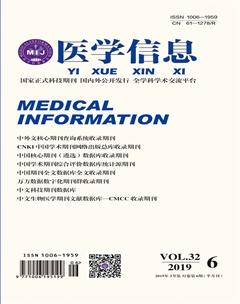巨噬细胞在腹主动脉瘤中作用的研究进展
汗尼萨·库地热提 郭志福
摘要:主动脉瘤(AAA)是因动脉中层结构破坏,动脉壁不能承受血流冲击的压力所致永久性局部或广泛血管扩张。相关研究证实,在主动脉瘤中被鉴定出来的先天性和获得性免疫细胞,包括嗜中性粒细胞、巨噬细胞、肥大细胞等可促进主动脉瘤的发展。形成AAA的主要危险因素有吸烟和家族史,然而在组织学层面上,AAA的发病特征包括炎症、平滑肌细胞凋亡,细胞外基质降解,氧化应激等。炎症反应在AAA中起着至关重要的作用,且主要影响主动脉壁重塑的决定性因素。本综述关注于主动脉瘤中的巨噬细胞的起源及巨噬细胞在AAA发展过程中的作用,充分描述巨噬细胞的潜在应用。
关键词:腹主动脉瘤;巨噬细胞;炎症反应
中图分类号:R543.1 文献标识码:A DOI:10.3969/j.issn.1006-1959.2019.06.020
文章编号:1006-1959(2019)06-0060-04
Abstract:Aortic aneurysm (AAA) is a permanent local or extensive vasodilation due to the destruction of the middle layer of the arteries and the inability of the arterial wall to withstand the effects of blood flow. Related studies have confirmed that congenital and acquired immune cells identified in aortic aneurysms, including neutrophils, macrophages, mast cells, etc., can promote the development of aortic aneurysms. The main risk factors for the formation of AAA are smoking and family history. However, at the histological level, the pathogenesis of AAA includes inflammation, smooth muscle cell apoptosis, extracellular matrix degradation, and oxidative stress. The inflammatory response plays a crucial role in AAA and primarily affects the determinants of aortic wall remodeling. This review focuses on the origin of macrophages in aortic aneurysms and the role of macrophages in the development of AAA, fully describing the potential applications of macrophages.
Key words:Abdominal aortic aneurysm;Macrophage;Inflammatory response
腹主動脉瘤(abdominal aortic aneurysm,AAA)是由多种因素引起的具有潜在破裂风险的主动脉病理扩张性疾病。大多数AAA患者常无症状,而瘤体一旦破裂,病死率极高,危害很大,相关文献[1]指出美国每年约有14000人死于腹主动脉瘤,占成人死亡原因中第13位,早期诊断、早期治疗是降低该病死亡率的惟一有效手段。目前,没有药物干预措施可以减缓AAA的生长并能防止破裂。永久性扩张或膨出的腹主动脉直径>正常的50%以上,就可以诊断为动脉瘤。一旦动脉瘤达到女性5.0 cm或男性5.5 cm,处理标准就是机械干预。虽在临床上开放或介入手术治疗方面有了显著进展,但是治疗性药物的缺乏,促使我们探讨主动脉瘤发生和进展相关机制的认识。
1 AAA中巨噬细胞的来源
几十年来,组织巨噬细胞被认为是从骨髓单核细胞渗入而来。然而,巨噬细胞个体发育的进步已经重新证实了这一概念。组织巨噬细胞起源于胚胎和胎儿期间迁移到组织中的胚胎祖细胞,并且在稳定状态下,大部分组织巨噬细胞在成年期间自主维持,独立在于骨髓祖细胞[2,3]。局部组织巨噬细胞的增殖参与心血管疾病的部分过程[4,5]并且与对照组主动脉相比,动脉瘤主动脉巨噬细胞中有更多的细胞增殖指数[6]。组织巨噬细胞和来自循环单核细胞的巨噬细胞浸润、增值可引起血管损伤[7]。研究表明[8],外周储存巨噬细胞的动员是致主动脉炎的主要机制,推测巨噬细胞在维持动脉粥样硬化的血管壁完整性方面也起着重要作用。
2巨噬细胞在AAA中的作用
2.1细胞外基质降解和血管壁重塑 巨噬细胞积聚于动脉瘤主动脉壁对组织损伤反应起着关键作用。人类AAA的病理学研究及动物模型显示[9,10],AAA的病理学特征包括细胞外基质(ECM)降解和血管平滑肌细胞(VSMC)丧失,其与炎细胞浸润于血管壁内外膜层有关,然而促进血管壁重塑、主动脉壁减弱。巨噬细胞通过抑制ECM重塑、促进和消除炎症反应,使破坏性组织重塑和修复性组织愈合失衡。ECM重塑是蛋白酶与其抑制剂活性之间平衡的结果。在AAA发展过程中,蛋白酶如组织蛋白酶和基质金属蛋白酶(MMPs)水平增加,这些酶的缺陷可保护AAA免受AAA的影响。相反,在缺乏金属蛋白酶组织抑制剂(TIMPs)的小鼠中观察到AAA进一步加重。与ECM降解有关的另一个过程是组织内的巨噬细胞侵袭和迁移。2017年发表的一项研究[11]显示,巨噬细胞渗入动脉瘤壁增加podosomes(是一种富含细胞骨架蛋白的结构)的形成。Krüppel样因子(KLF)5的基因和蛋白质水平在小鼠和人AAA中的巨噬细胞中增加。KLF5通过上调Myo9b转录并抑制RHOA信号促进podosome的形成和巨噬细胞的迁移,并且KLF5的存在增加对实验AAA的可感性。然而,巨噬细胞中KFL5依赖性的动脉瘤效应是否需要podosome本身暂不明确。
2.2炎症反应 除了ECM降解、血管壁重塑之外,炎症是动脉瘤病理生理学的主要特征之一。巨噬细胞产生并影响炎症介质[12]。动脉瘤壁中的巨噬细胞是趋化因子CXCL1的主要来源,它吸引和召集产生白介素-6(IL-6)的嗜中性粒细胞。如上所述,在动脉瘤形成期间增加的IL-6水平促进单核细胞分化为分泌CCL2的激活大分子噬菌体,其继而促进更多单核细胞聚集于主动脉。细胞因子是炎症反应的重要介质,也是主动脉壁各种免疫和非免疫细胞的重要调节因子。相关细胞因子在AAA中直接作用的大部分认识来自于不完整的动物实验研究。典型炎性通路组(Nlrp3,Pycard,Casp1或Il1b)105,106或Tnf107或IL-6的不完整性实质上限制了AAA的发展。相反,编码免疫抑制细胞因子减少金属蛋白酶(MMP)活化、保持ECM完整性的全部缺失加重AAA的形成[13]。有趣的是,在人类AAA外植体培养物中发现IL-6和IL-10产生负相关,这两种细胞因子之间平衡似乎可调节主动脉壁免疫应答[14]。在具有髓样细胞特异性KLF6(Kruppel-like factor 6)基因缺陷的动物模型例子提供了白细胞,特别是巨噬细胞对AAA炎症过程中直接作用的更好证据。KLF6是一种在巨噬细胞中稳健产生的转录因子[15]。全身性缺失KLF6杂合的小鼠以及骨髓细胞特异性KLF6缺失的小鼠具有AAA恶化的表现,具有巨噬细胞在主动脉壁的浸润增加和主动脉壁中IL-6的高表达。研究人员表明,粒细胞巨噬细胞集落刺激因子(GMCSF)是KLF6的直接靶点,使巨噬细胞增加的GMCSF的产生促进了AAA的发展[16]。此外,除趋化因子和細胞因子以外的多种因素能调节巨噬细胞炎性活性,可以影响AAA的发展[17]。
2.3组织愈合和修复促进 ECM降解、炎症反应之外,巨噬细胞噬菌体对于组织愈合反应期间的重塑极其重要。AAA发展期间聚集主动脉壁的组织碎片和毒性产物,如细胞外血红蛋白[18]可被巨噬细胞吞噬。目前指出AAA期间一些巨噬细胞亚组的保护作用——介导血红蛋白清除,调节氧化应激和炎症反应。值得注意的是,尽管它们在清除有毒产物方面起作用,但巨噬细胞可以产生大量的活性氧。然而,AAA期间氧化应激对巨噬细胞活性的影响似乎比最初预期的更复杂。例如,在血栓调节蛋白缺陷小鼠中观察到的抗AAA形成的保护部分归因于巨噬细胞产生活性氧物的减少[19]。然而,AAA中巨噬细胞依赖性氧化应激的作用需要进一步研究[20]。总之,巨噬细胞通过参与ECM重塑,炎症和氧化应激而在AAA病理生理学中具有致病和保护功能。这些功能的调节极其复杂,因受到微环境影响,在疾病进展不同的阶段可发生变化。除上述作用之外,可认为巨噬细胞在AAA发病机制中的其他功能值得进一步探讨。例如,巨噬细胞参与凋亡碎片的清除。减弱吞胞作用改变动脉粥样硬化[21,22]和缺血性心血管疾病[23,24]进展,且体外细胞病可能与AAA背景下的组织重塑和修复高度相关。产生凝血因子Ⅷa的CXCR3+巨噬细胞以CXCL10依赖的方式积累在人类AAA外膜中,可以促进基质交联并限制主动脉壁的动脉瘤扩张[25]。2016年发表的一项研究证实血管周围巨噬细胞对非病理状态下血管通透性的作用[26]。AAA壁增厚往往与显微解剖相关,并假设AAA外膜巨噬细胞调节血管渗透性的作用是可行性的。皮肤巨噬细胞通过血管内皮生长因子C(VEGFC)依赖于淋巴毛细血管网络的调节来调节盐依赖性[27]。主动脉壁巨噬细胞是否也具有这样的作用尚不清楚,值得进一步研究,因已知间质液压调节主动脉瘤发病机制中起作用以及对主动脉夹层中有易感[28]。
3潜在应用
巨噬细胞可作为AAA诊断和预后的生物标志物。除了作为循环生物标志物的潜在用途之外,实验研究还表明巨噬细胞可以用作成像目标。通过检测超小型超顺磁性氧化铁颗粒(USPIO)的吞噬作用,可通过MRI追踪巨噬细胞活性。表明该技术在评估巨噬细胞依赖过程对体内AAA进展的影响方面具有潜在效用。在AAA治疗中炎症细胞-巨噬细胞可作为治疗靶点。结合使用更有针对性的抗炎治疗方法来检测具有活性炎症成分的AAA,可能有助于AAA患者的治疗。这种联合诊断和治疗方法的另一个实例是检测AAA中18FFDG摄取增加,表明糖酵解活性高,随后使用糖酵解抑制剂以限制巨噬细胞活化[29]。这种方法已被证明在AAA155的动物模型中是成功的,需要考虑将来转化为人类环境。然而,巨噬细胞表型和活性的调节是另一种治疗选择。实验证明,静脉注射M2巨噬细胞对氯化钙诱导的动脉瘤具有保护作用,如存活率的提高,主动脉扩张的减少和弹性蛋白的保存等等[30]。因此,已知对巨噬细胞极化有影响的治疗策略或药物可能是有意义的。
4展望
根据实验和临床研究的发现,可以提出基础研究和转化研究的几个未来方向。即使已确定不同巨噬细胞亚群及其独特起源,作用和功能似乎比预期更复杂,降低主动脉壁促炎M1破骨细胞样巨噬胞NOS2+巨噬细胞ECM降解、膨胀性重塑、显微切割、新血管形成等各方面仍待阐明。流行病学研究突出了AAA与危险因素之间的关联,包括年龄、男性、吸烟、高血压和低HDL胆固醇水平,并且这些因素可以影响巨噬细胞的活性和功能[31-36]。需要进一步的研究来探索这些危险因素与巨噬细胞对AAA作用的分子途径。近十年来AAA实验模型的发展,为研究巨噬细胞在AAA发病机制中的作用提供了巨大的机会。然而,这些模型都没有完整的人体研究,提示开发相关模型的真正需求[37,38]。
5总结
在从初始发育到发生显微解剖和破裂的AAA形成的所有阶段中,巨噬细胞均起作用。在过去的几十年中,我们在了解聚集血管损伤部位的巨噬细胞及其分化、增殖、激活和表型转换机制方面取得了令人瞩目的进展,并且得到了先进成像技术发展的支持。该技术用于检测和追踪巨噬细胞在体内的积累和活化,开发新的抗炎理论以及其他技术改进,这些改进将能够选择性操纵各种巨噬细胞功能。我们确信这些创新方法将会改善AAA患者的分层和管理。
參考文献:
[1]Erica M.C. Kemmerling,Robert A.Peattie.Abdominal Aortic Aneurysm Pathomechanics: Current Understanding and Future Directions[J].Advancesin Experimental Medicine and Biology,2018,1097(10):157-179.
[2]Perdiguero EG,Geissmann F.The development and maintenance of resident macrophages[J].Nature Immunology,2016,17(1):2-8.
[3]Ginhoux F,Guilliams M.Tissue-Resident Macrophage Ontogeny and Homeostasis[J].Immunity,2016,44(3):439-449.
[4]Lhoták S,Gyulay G,Cutz Jean-Claude,et al.Characterization of Proliferating Lesion-Resident Cells During All Stages of Atherosclerotic Growth[J].Journal of the American Heart Association,2016,5(8):e003945.
[5]Lavine KJ,Epelman S,Uchida K,et al.Distinct macrophage lineages contribute to disparate patterns of cardiac recovery and remodeling in the neonatal and adult heart[J].Proceedings of the National Academy of Sciences,2014,111(45):16029-16034.
[6]Dutertre CA,Clement M,Morvan M,et al.Deciphering the Stromal and Hematopoietic Cell Network of the Adventitia from Non-Aneurysmal and Aneurysmal Human Aorta[J].PLoS One,2014,9(2):e89983.
[7]Woollard KJ,Geissmann F.Monocytes in atherosclerosis: subsets and functions[J].Nature Reviews Cardiology,2010,7(2):77-86.
[8]Ensan S,Li A,Besla R,et al.Self-renewing resident arterial macrophages arise from embryonic CX3CR1+ precursors and circulating monocytes immediately after birth[J].Nat Immunol,2016,17(2):159-168.
[9]Hong H,Yang Y,Liu B,et al.Imaging of Abdominal Aortic Aneurysm: The Present and the Future[J].Current Vascular Pharmacology,2010,8(6):808-819.
[10]Trollope A,Moxon JV,Moran CS,et al.Animal models of abdominal aortic aneurysm and their role in furthering management of human disease[J].Cardiovascular Pathology,2011,20(2):114-123.
[11]Ma D,Zheng B,Suzuki T,et al.Inhibition of KLF5-Myo9b-RhoA Pathway-Mediated Podosome Formation in Macrophages Ameliorates Abdominal Aortic Aneurysm[J].Circulation Research,2017,120(5):799-815.
[12]Mallat Z.Macrophages[J].Arteriosclerosis,Thrombosis,and Vascular Biology,2014,34(10):2509-2519.
[13]Ait-Oufella H,Wang Y,Herbin O,et al.Natural Regulatory T Cells Limit AngiotensinⅡ-Induced Aneurysm Formation and Rupture in Mice[J].Arteriosclerosis Thrombosis and Vascular Biology,2013,33(10):2374-2379.
[14]Vucevic D,Maravic-Stojkovic V,Vasilijic S,et al.Inverse production of IL-6 and IL-10 by abdominal aortic aneurysm explant tissues in culture[J].Cardiovascular Pathology,2012,21(6):482-489.
[15]Date D,Das R,Narla G,et al.Kruppel-like Transcription Factor 6 Regulates Inflammatory Macrophage Polarization[J].Journal of Biological Chemistry,2014,289(15):10318-10329.
[16]Son BK,Sawaki D,Tomida S,et al.Granulocyte macrophage colony-stimulating factor is required for aortic dissection/intramural haematoma[J].Nature Communications,2015,29(6):6994.
[17]Tazume H,Miyata K,Tian Z,et al.Macrophage-derived angiopoietin-like protein 2 accelerates development of abdominal aortic aneurysm[J].Arteriosclerosis Thrombosis & Vascular Biology,2012,32(6):1400-1409.
[18]Rifkind JM,Mohanty JG,Nagababu E.The pathophysiology of extracellular hemoglobin associated with enhanced oxidative reactions[J].Front Physiol,2014(5):500.
[19]Wang K,Li Y,Shi G,et al.Membrane-Bound Thrombomodulin Regulates Macrophage Inflammation in Abdominal Aortic Aneurysm[J].Arteriosclerosis Thrombosis & Vascular Biology,2015,35(11):2412-2422.
[20]Sharma AK,Salmon MD,Lu G,et al.Mesenchymal Stem Cells Attenuate NADPH Oxidase-Dependent High Mobility Group Box 1 Production and Inhibit Abdominal Aortic Aneurysms[J].Arteriosclerosis Thrombosis & Vascular Biology,2016,36(5):908-918.
[21]Kojima Y,Downing K,Kundu R,et al.Cyclin-dependent kinase inhibitor 2B regulates efferocytosis and atherosclerosis[J].Journal of Clinical Investigation,2014,124(3):1083-1097.
[22]Kojima Y,Volkmer JP,McKenna K,et al.CD47-blocking antibodies restore phagocytosis and prevent atherosclerosis[J].Nature,2016,536(7614):86-90.
[23]Wan E,Yeap XY,Dehn S,et al.Enhanced efferocytosis of apoptotic cardiomyocytes through myeloid-epithelial-reproductive tyrosine kinase links acute inflammation resolution to cardiac repair after infarction[J].Circulation Research,2013,113(8):1004-1012.
[24]Howangyin KY,Zlatanova I,Pinto C,et al.Myeloid-Epithelial-Reproductive Receptor Tyrosine Kinase and Milk Fat Globule Epidermal Growth Factor 8 Coordinately Improve Remodeling After Myocardial Infarction via Local Delivery of Vascular Endothelial Growth Factor[J].Circulation,2016,133(9):826-839.
[25]Zhou J,Tang PCY,Qin L,et al.CXCR3-dependent accumulation and activation of perivascular macrophages is necessary for homeostatic arterial remodeling to hemodynamic stresses[J].Journal of Experimental Medicine,2010,207(9):1951-1966.
[26]He H,Mack JJ,Gü? E,et al.Perivascular Macrophages Limit Permeability[J].Arteriosclerosis Thrombosis & Vascular Biology,2016,59(9):2203-2212.
[27]Machnik A,Neuhofer W,Jantsch J,et al.Macrophages regulate salt-dependent volume and blood pressure by a vascular endothelial growth factor-C-dependent buffering mechanism[J].Nat Med,2009,15(5):545-552.
[28]Mallat Z,Tedgui A,Henrion D.Role of microvascular tone and extracellular matrix contraction in the regulation of interstitial fluid: implications for aortic dissection[J].Arterioscler Thromb Vasc Biol,2016,36(9):1742-1747.
[29]Tsuruda T,Hatakeyama K,Nagamachi S,et al.Inhibition of Development of Abdominal Aortic Aneurysm by Glycolysis Restriction[J].Arteriosclerosis,Thrombosis,and Vascular Biology,2012,32(6):1410-1417.
[30]Dale MA,Xiong W,Carson JS,et al.Elastin-Derived Peptides Promote Abdominal Aortic Aneurysm Formation by Modulating M1/M2 Macrophage Polarization[J].Journal of Immunology,2016,196(11):4536-4543.
[31]Howangyin KY,Zlatanova I,Pinto C,et al.Myeloid-Epithelial-Reproductive Receptor Tyrosine Kinase and Milk Fat Globule Epidermal Growth Factor 8 Coordinately Improve Remodeling After Myocardial Infarction via Local Delivery of Vascular Endothelial Growth Factor[J].Circulation,2016,133(9):826-839.
[32]Fulop T,Dupuis G,Baehl S,et al.From inflamm-aging to immune-paralysis: a slippery slope during aging for immune-adaptation[J].Biogerontology,2015,17(1):147-157.
[33]Campesi I,Marino M,Montella A,et al.Sex differences in estrogen receptor α and β levels and activation status in LPS-stimulated human macrophages[J].Journal of Cellular Physiology,2017,232(2):340-345.
[34]Aruna B,Kaur SH,Gurpreet K.Sex Hormones and Immune Dimorphism[J].Scientific World Journal,2014(11):159150.
[35]Qiu F,Liang CL,Liu H,et al.Impacts of cigarette smoking on immune responsiveness: Up and down or upside down?[J].Oncotarget,2017,8(1):268-284.
[36]Wright MD,Binger KJ.Macrophage heterogeneity and renin-angiotensin system disorders[J].Pflügers Archiv-European Journal of Physiology,2017,469(3-4):445-454.
[37]Sénémaud J,Caligiuri G,Etienne H,et al.Translational Relevance and Recent Advances of Animal Models of Abdominal Aortic Aneurysm[J].Arteriosclerosis,Thrombosis,and Vascular Biology,2017,37(3):401-410.
[38]Raffort J,Lareyre F,Clément M,et al.Monocytes and macrophages in abdominal aortic aneurysm[J].Nature Reviews Cardiology,2017,14(8):457-471.
收稿日期:2018-12-16;修回日期:2018-12-27
編辑/杨倩

